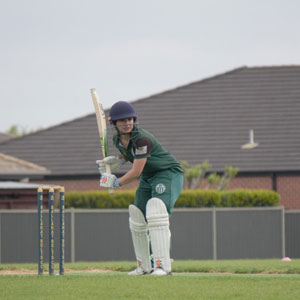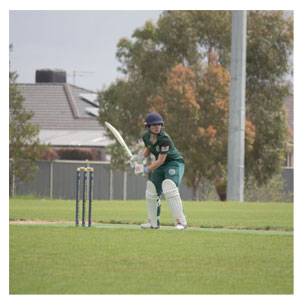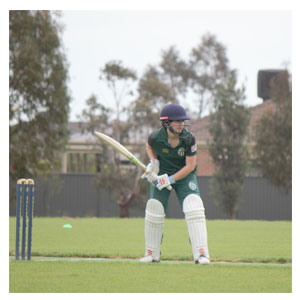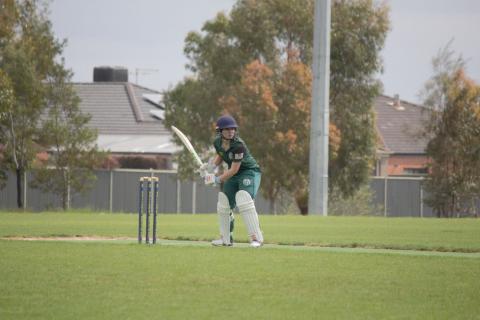The iconic summer sport that is cricket 🏏
 The iconic summer sport that is cricket is well loved by many. That victorious feeling when you crack the ball right in the sweet spot of the bat and off it runs to the boundary. Or taking that catch, and surprising even yourself that it stuck. Cricket is a fun and challenging team sport for all those who choose to dedicate time and energy to learning it nuances and advancing their technique and skills.
The iconic summer sport that is cricket is well loved by many. That victorious feeling when you crack the ball right in the sweet spot of the bat and off it runs to the boundary. Or taking that catch, and surprising even yourself that it stuck. Cricket is a fun and challenging team sport for all those who choose to dedicate time and energy to learning it nuances and advancing their technique and skills.
It can also be associated with the feeling of pain and restriction from injuries when we chase that winning feeling. Like any passion, we take risks in search of victory. Sometimes it pays off, and sometimes we get injured.
So let's talk about a couple of common cricket injuries and how an Osteopath may assist you.
Firstly, let's discuss lower back pain. Given the nature of bowling technique in particular, lower back injuries are common. Particularly for our growing juniors as their developing bones are relatively less strong. Care needs to be taken to ensure their technique is sound in order to avoid excessive abnormal forces on the spine. Clubs and players need to limit the amount of stress on a junior bowler's body by adhering to recommended graduated bowling volumes. This starts from the preparation and training stage, all the way through to match targets. Rest and recovery days are important too as growing bodies need time to adapt. Cricket Australia has some further info regarding their recommendations for junior bowling in a document titled "Cricket Australia Junior Bowling Guidelines 2019/20", as downloadable through a google search for those interested in further reading.
Lower back strains and sprains are a common injury related to bowling due to the force acting on the local area. When players come to see us about these types of injuries, we assess the local area as well as the body as whole. We utilise different treatment techniques as part of our hands on treatment, and provide advice towards stretches and exercises as part of your rehab program. It is important your coach is aware of your injury so they can place high importance on addressing your technique, altering your training/game load and managing recovery days in light of your condition.
 It is not only sprains and strains that can affect the lower back. More progressed conditions such as stress fractures need to be considered. Spondylolysis is the name of a stress fracture of the lower spine. Spondylolisthesis is where there are stress fractures in the lower spine that results in forward movement of the affected spinal bone. A thorough assessment and scans can assist in determining the extent of the back injury, and hence the management plan options available. For these more serious injuries of spondylosis and spondylolisthesis, your doctor or sports physician will be involved as there will be a need to assess the extent of the bony involvement and to make sure you are cleared as safe to begin exercise rehabilitation and a return to sport. In these cases, conservative management may suffice, however surgical treatment may be considered in certain situations. We happily work alongside your healthcare team during your recovery.
It is not only sprains and strains that can affect the lower back. More progressed conditions such as stress fractures need to be considered. Spondylolysis is the name of a stress fracture of the lower spine. Spondylolisthesis is where there are stress fractures in the lower spine that results in forward movement of the affected spinal bone. A thorough assessment and scans can assist in determining the extent of the back injury, and hence the management plan options available. For these more serious injuries of spondylosis and spondylolisthesis, your doctor or sports physician will be involved as there will be a need to assess the extent of the bony involvement and to make sure you are cleared as safe to begin exercise rehabilitation and a return to sport. In these cases, conservative management may suffice, however surgical treatment may be considered in certain situations. We happily work alongside your healthcare team during your recovery.
Cricketers also frequently suffer from upper extremity injuries of the shoulder, elbow and wrist. They may be related to a specific trauma, or linked to one's bowling, throwing, or batting action. Specific traumatic incidents can include a rapid, hard throw back to the stumps, or a traumatic fall onto an outstretched arm when diving to field the ball. Examples of injuries from repetitive actions may include an awkward batting grip or swing, or a joint strain with poor bowling or throwing technique. Whatever the cause, it's important to address the injured tissue as soon as possible with first aid techniques. Bandages and strapping may be used to support the joint and prevent excessive movements and further tissue trauma. As osteopaths we will assess the injured area, as well as surrounding structures for potential compensations, as well as contributing and maintaining factors. For example, let's say we have a pace bowler who comes in with early shoulder pain in their dominant arm, and with restriction in bringing the arm high into its full rotation. Your osteopath will consider of course the shoulder itself, but also the other structures that are connected. Spine and rib cage motion affect shoulder blade motion and thus the shoulder joints ability to access its full range of motion. A restricted hunched midback could internally rotate the shoulder blade and reduce the arc motion available at the shoulder joint. Restricted ribs may also reduce the rotation available through the torso and limit its ability to twist through the stages of delivery. We look at the surrounding connections to the shoulder, including the tissues at the front at the chest, above and below, and the arm itself. Even a hip restriction may limit the stride length and ability to follow through. Muscles that are too tight or weak may be part of the picture and affecting joint and tissue function. We like to consider the whole body, so a shoulder injury will have us considering more mechanics than the local shoulder. We ask lots of questions about your past history to piece together how it may be relevant to your current condition. We provide homework to you regarding stretches, exercises, warm ups/cool downs, movement pattern training and other taping/strapping advice as needed. Sometimes scans are needed to aid your diagnosis and management and we will discuss these options with you if applicable, particularly when considering rotator cuff tears or labral injuries.
 Ankle sprains are the final injury I wanted to talk about, as these joints seem to hog the limelight and manage to get injured in pretty much most sports. The symptoms of pain, swelling and bruising are caused the overstretching and or tearing of the ankle ligaments that would ordinarily stabailise the ankle joint. One can usually still weight bear after a mild to moderate ankle sprain. Hobble off the field to rest your ankle, apply ice packs for 15mins, every couple of hours, whilst also elevating the ankle to assist in reducing swelling over the first 48hours. If the ankle sprain is severe and you cannot walk up to 4 steps immediately after the injury, xrays will be important in ruling out a fracture. Recurrent ankle sprains can also be an issue due to lax ligaments. These may also affect your confidence in applying yourself during sport due to fear of recurrence. Both recent, or chronic ankle sprain can be addressed by osteopaths. Again, we assess the local area as well as surrounding structures. We look specifically at a gradual, tailored exercise rehabilitation program to help you return to activity. Exercises are specific to your needs and sporting requirements. In cricket, these include the quick start and stops, running, changing of directions and side stepping, loading limbs through bowling phases and the moving of feet while batting. By increasing your lower limb function, increasing strength and stability, giving you tools for self management (warm ups/cool downs/strapping/etc) and considering the body as a whole, we hope to provide you with confidence in your body again as you return to sport and reduce the risk of reinjury.
Ankle sprains are the final injury I wanted to talk about, as these joints seem to hog the limelight and manage to get injured in pretty much most sports. The symptoms of pain, swelling and bruising are caused the overstretching and or tearing of the ankle ligaments that would ordinarily stabailise the ankle joint. One can usually still weight bear after a mild to moderate ankle sprain. Hobble off the field to rest your ankle, apply ice packs for 15mins, every couple of hours, whilst also elevating the ankle to assist in reducing swelling over the first 48hours. If the ankle sprain is severe and you cannot walk up to 4 steps immediately after the injury, xrays will be important in ruling out a fracture. Recurrent ankle sprains can also be an issue due to lax ligaments. These may also affect your confidence in applying yourself during sport due to fear of recurrence. Both recent, or chronic ankle sprain can be addressed by osteopaths. Again, we assess the local area as well as surrounding structures. We look specifically at a gradual, tailored exercise rehabilitation program to help you return to activity. Exercises are specific to your needs and sporting requirements. In cricket, these include the quick start and stops, running, changing of directions and side stepping, loading limbs through bowling phases and the moving of feet while batting. By increasing your lower limb function, increasing strength and stability, giving you tools for self management (warm ups/cool downs/strapping/etc) and considering the body as a whole, we hope to provide you with confidence in your body again as you return to sport and reduce the risk of reinjury.
A couple of final notes on general cricket considerations before you go. Cricket is a summer sport that takes a good chunk of the day, and Australian grounds can sure get hot. Always keep an eye out to prevent heat stress. Look after yourself and the team with regular hydration and staying in the shade when possible, slip/slop/slap/slide, regular small meals and using wet towels on the skin to keep cool. Check in with your body regularly, if it's telling you that it needs a break, act early by subbing off, telling your team and implementing further measures as mentioned previously. Prevention is always better than cure. Heat stroke can happen after heat stress. It is when the core body temperature rises above 40.5 oC and the body's internal systems start to shut down as it can no longer control its internal temperature through sweating. Heat stroke is a medical emergency.
There are lots of other injuries related to this wonderful world of cricket. Galactic purple cricket ball bruises and hand injuries from the leather ball travelling at the speed of light are almost part and parcel with the game. Do make sure you look after yourself, seek first aid ASAP after an injury and follow up with your healthcare provider for next steps if it concerns you. We have lots of practitioners ready to play their part in your recovery. And we happily work alongside your wider healthcare team which may include your GP, a sports physician, hand therapist, exercise physiologist, as well as your coach and your biggest fans (the dedicated adults of the junior players!!), just to name a few.
If you have further question or would like to come in to consult with one of our Osteopaths, please call the clinic on 9431 6604 or book online at: https://yourbodyosteopathy.bookings.pracsuite.com/guest

